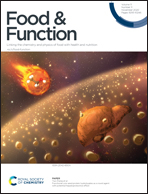Prebiotic effects of pectooligosaccharides obtained from lemon peel on the microbiota from elderly donors using an in vitro continuous colon model (TIM-2)†
Abstract
The development of new prebiotics capable of modulating the gut microbiota in the elderly has become an area of great interest due to the particular vulnerability and frailty of this population. In the present work, mixtures of pectin-derived oligosaccharides (POS) were manufactured from lemon peel waste and evaluated for their capability to modulate the gut microbiota using, as inoculum, a pool of faeces from elderly donors. Both changes in the microbiota and the metabolic activity were assessed and compared with commercial fructooligosaccharides (FOS) and the standard ileal efflux medium (SIEM) using the TIM-2 in vitro colon model. POS fermentation led to similar or even better effects than FOS at phylum, family and genus levels. Higher increments in beneficial species such as Faecalibacterium prausnitzii and larger alpha diversity values were observed with POS in comparison with FOS and in some cases with SIEM. The PCoA analyses revealed that the microbial profiles resulting from POS and FOS bacterial fermentation were rather similar and differed from those observed after SIEM fermentation. Finally, although butyrate cumulative production was comparable among substrates, the highest short chain fatty acid (SCFA) and the lowest branched chain fatty acid (BCFA) cumulative production was observed in POS experiments. These results support the potential of pectin-derived oligosaccharides as prebiotic candidates targeting gut health in the elderly.



 Please wait while we load your content...
Please wait while we load your content...